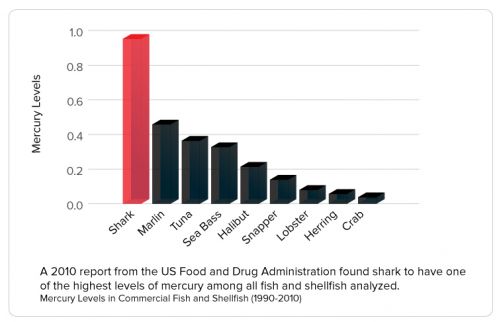Shark fin soup has erroneously been associated with positive heath benefits. However there is no accepted scientific evidence that shark fin provides any medicinal or health benefit. In fact studies show that shark has among the highest levels of mercury and other dangerous toxins found in fish.
Marine organisms absorb and cannot excrete some toxins and heavy metals that enter the oceans from pollutants. These toxins accumulate in a fish’s body as it eats other fish, known as "bioaccumulation1," and travel through the food web from prey to predator, continuing to increase in density in a process called "biomagnification2."
At the top of the food chain are the ‘apex’ predators: sharks. Some shark species can live for 50 years or more, consuming many toxin-laden fish and storing those toxins in their bodies throughout their lifetime. When we eat shark fin soup, we are consuming their toxins, too.

Methylmercury is an organic form of mercury, a neurotoxin. Organizations throughout the world, including the United States Environmental Protection Agency (USEPA), the World Health Organization (WHO) and the Food and Agriculture Organization of the United Nations (FAO), recognize mercury to be a dangerous neurotoxin and warn against eating shark, especially pregnant women, women who plan to become pregnant, or children.
Methylmercury exposure can cause serious neurological and heart problems and has been linked to infertility3. One quarter of 70 uncooked fins from a Hong Kong market contained mercury concentrations well above the World Health Organization’s guidelines, enough to be identified as a significant threat to children and babies4.
Another recent study found that 79% of shark fins tested contained high-levels of BMAA, a dangerous neurotoxin linked to increased risk of Alzheimer’s and other degenerative brain diseases5.
Levels of Arsenic contamination in one single fin can be 13-32 times China’s national guideline for marine products and 10% of all dried seafood items in Hong Kong, mostly shark fins, contain impurities such as hydrogen peroxide and formaldehyde, each considered hazardous to human health6.
1 - Suk, S.H., Smith, S.., and Raon, D.A., 2009. Bioaccumulation of mercury in pelagic sharks from the northeast Pacific Ocean. California COFI Report, 5: 172-177.
2 - Escobar-Sanchez, O., F. Galvan-Magana, et al. 2010. Mercury and selenium bioaccumulation in the Smooth Hammerhead shark, Sphyrna zygaena Linnaeus, from the Mexican Pacific Ocean. Bulletin of Environmental Contamination and Toxicology 84: 488-491.
3 – Mergler, D., Anderson, H.A., Chan, L.H.M., Mahaffey, K.R., Murray, M., Sakamoto, M., and Stern, A.H. 2007. Methylmercury exposure and health effects in humans: a worldwide concern. AMBIO Journal of Human Environment, 36(1): 3-11.
4 - Timms, T., Gonzalez, L., and Trent, S. 2009. In the Soup: how mercury poisons the fish we
eat. WildAid, 20 pp.
5 - Mondo, K., Hammerschlag, N., Basile, M., Pablo, J., Banack, S.A., and Mash, D.C. 2012. Cyanobacterial neurotoxin β-N-Methylamino-L-alanine (BMAA) in shark fins. Marine Drugs, 10: 509-520.
6 - Dickman, M.D., C.K. Leung, and M.K. Leung. 1998. Hong Kong Male Subfertility Links to Mercury in Human Hair and Fish. Science of the Total Environment 214:165–74.; Anon 2004. 10 pc of Dried Seafood Toxic. The Hong Kong Standard Newspaper, 5
February 2004. Available at www.accessmylibrary.com/comsite5/bin/comsite5.pl in January 2007; Clarke, S. 2004. Shark Product Trade in Mainland China and Hong Kong and Implementation of the CITES Shark Listings. Hong Kong: TRAFFIC East Asia. Available at http://www.traffic.org/content/232.pdf